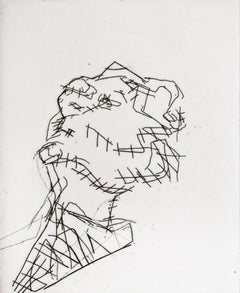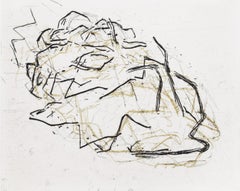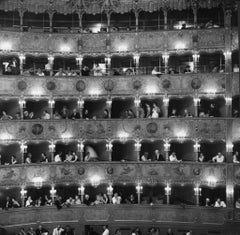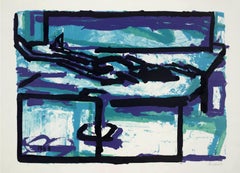Frank Auerbach Art
Frank Auerbach was one of Britain’s pre-eminent postwar artists. His subject matter is rooted in his north London surroundings or people he knew well — painting and drawing them over and over again. His oils, drawings, and prints reveal an intense observation of the subject; he made his mark with authority and finality, to arrive at the essence of his subject.
Auerbach’s signature thick black lines and the furious mark-making he employed give his work an energetic quality. He held a deep reverence for the “magic” of printmaking, particularly etching and dry point, to reveal the essential qualities he sought to express. He had completed, however, fewer than 40 editions throughout his career but increasingly worked on a larger scale on a par with painting.
For weeks and sometimes years, Auerbach observed and portrayed the same people from among his circle of acquaintances who were asked to sit for him at regular times and days of the week, so that he could draw and paint them obsessively, over and over again, giving them rigorous attention. His work is an expression of his very personal vision and experience by means of repetition and limitation, to concentrate the search for insight: into another person, into the self and into the world. His personal story is telling.
Auerbach was born in Berlin in 1931 but was sent to a boarding school for Jewish refugee children in Kent in 1939. His parents, who remained in Germany, died in concentration camps. He studied at St Martin’s School of Art, from 1948 to 1952. Auerbach met David Bomberg in night classes at Borough Polytechnic and developed a friendship with fellow student Leon Kossoff. He then went on to study at the Royal College of Art from 1952 to 1955.
Auerbach exhibited regularly at the Beaux-Arts Gallery until 1963. From 1965 he exhibited at the Marlborough Gallery and was given an Arts Council retrospective at the Hayward Gallery, London in 1978, and had solo exhibitions at the British Pavilion in the 1986 Venice Biennale, and at the Rijksmuseum Vincent Van Gogh, Amsterdam, 1989. Rarely leaving England, he had the same studio since the 1950s.
Auerbach’s work can be found in public collections worldwide including the British Museum, London, England; Cleveland Museum of Art, Cleveland, Ohio; Frissiras Museum of Contemporary Art, Athens, Greece; Israel Museum, Jerusalem, Israel; The Metropolitan Museum of Art, New York; Museo de Arte Moderna da Bahia, Salvador, Brazil; Museo Rufino Tamayo, Mexico City, Mexico; Museum of Modern Art, New York; National Gallery of South Africa, Cape Town, South Africa; Royal College of Art, London, England; Scottish National Gallery of Modern Art, Edinburgh, Scotland; Tate Britain, London, England.
Find Frank Auerbach art for sale on 1stDibs.
(Biography provided by Joanna Bryant Projects)
1990s Frank Auerbach Art
Etching
Early 2000s Frank Auerbach Art
Etching
Mid-20th Century Modern Frank Auerbach Art
Etching
1940s Frank Auerbach Art
Etching
1930s American Modern Frank Auerbach Art
Drypoint, Etching
1960s Surrealist Frank Auerbach Art
Etching
1920s Realist Frank Auerbach Art
Etching
1870s Impressionist Frank Auerbach Art
Etching
1920s Modern Frank Auerbach Art
Etching
1920s Modern Frank Auerbach Art
Drypoint, Etching
1880s Frank Auerbach Art
Drypoint, Etching
1930s Realist Frank Auerbach Art
Etching
1920s Realist Frank Auerbach Art
Etching
1970s Modern Frank Auerbach Art
Etching
1950s Modern Frank Auerbach Art
Silver Gelatin
1960s Abstract Frank Auerbach Art
Screen
Early 2000s Contemporary Frank Auerbach Art
Etching
Early 2000s Contemporary Frank Auerbach Art
Etching
Frank Auerbach art for sale on 1stDibs.
Artists Similar to Frank Auerbach
- What is Frank Auerbach style?1 Answer1stDibs ExpertApril 5, 2022Frank Auerbach is a figure painter whose work has been described as expressionist, however, he more accurately fits into the neo-expressionist classification. He’s also been known for creating semi-abstract portraits, which puts him more accurately in the modern art movement. On 1stDibs, find a variety of original artwork from top artists.



